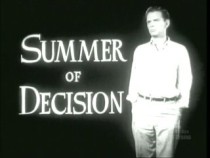NOTE: The full version of this article was published in December 2014 and can be found here.
In the late 1940s, stage actress and singer Kyle MacDonnell became one of television’s very first stars, earning the nickname Miss Television and wide praise from critics. Between 1948 and 1951 she hosted a number of shows and made guest appearances on many others. She took a break from show business in 1951 to have a baby and her television career never recovered. When she died in 2004, her role as a television pioneer had been all but forgotten.
The third part of this article covers Kyle’s return to Broadway after the cancellation of the second incarnation of For Your Pleasure, her appearances on Cavalcade of Stars, Celebrity Time, and the last network television series she hosted, Hold That Camera. Part 1 can be found here; read Part 2 here.
Interlude: A Return to Broadway & Cavalcade of Stars
For the first time in almost a year and a half, Kyle didn’t have a television series to host every week. She returned quickly to the theater as a featured performer in a new Broadway revue called Touch and Go. The production’s sketches and lyrics were written by theater critic Walter Kerr and his wife Jean Kerr. The pair’s earlier collaboration, a 1946 Broadway play called The Song of Bernadette, ran for just three performances. Jean Kerr would later write Please Don’t Eat the Daisies in 1957, which was turned into a movie in 1960 and a television series in 1965.
Walter Kerr also directed the revue, which was produced by George Hall and presented by George Abbott, with music by Jay Gorney and choreography by Helen Tamiris. It opened at the Broadhurst Theatre, where Kyle had previously appeared in Make Mine Manhattan, on October 13th, 1949. Kyle appeared in six sketches in the revue, playing the title character in parody of the Cinderella story, Ophelia in a satire of Hamlet, and a glamorous movie star appearing in a scene with a gorilla in which the great ape turns out to be smarter than the leading man.
Brooks Atkinson, reviewing Touch and Go for The New York Times, praised the young cast. Kyle, he wrote, “is radiantly beautiful, has a sense of humor and can sing remarkably well–qualities said to be common to all the women in Texas.” The revue ran for a total of 176 performances, closing on March 18th, 1950. It would be Kyle’s last time on Broadway.
A week later, on Saturday, March 25th, Kyle made her first of five guest appearances on DuMont’s Cavalcade of Stars, hosted by Jerry Lester. Other guests that night included Chester Morris and Dizzy Gillespie. She would then make four consecutive appearances on the series from April 8th to April 22nd. It’s likely that she sang in many or all of these episodes. She also appeared in sketches.
(Lester was the variety show’s second host, having replaced original host Jack Carter less than a month earlier. Carter hosted the series from its debut in June 1949 through February 1950. Lester was himself replaced as host in July 1950 by Jackie Gleason.)
Celebrity Time
A few weeks after her last guest appearance on Cavalcade of Stars, Kyle became a permanent panelist on the CBS game show Celebrity Time. The show had a complicated history involving two networks, a number of name changes, and multiple hosts. It premiered in November 1948 as a local program on WCBS-TV in New York City under the name The Eyes Have It. Within a few weeks its title had changed first to Stop, Look and Listen and then Riddle Me This. Douglas Edward was the first host, replaced almost immediately by Paul Gallico. Conrad Nagel took over as host in December 1948.
The series featured four panelists (typically two men competing against two women) who had to identify people and events from old newsreel footage and other films. Over time, the format changed a bit to include skits and musical performances. In January 1949 the series began airing on the CBS Eastern network. In April 1949, the series picked up a new sponsor (B.F. Goodrich), a new name (Celebrity Time), and a new network (it shifted to ABC). By that point, John Daly and Ilka Chase had become permanent panelists, joined each week by two guest panelists. Throughout all these changes, the series remained a Sunday night fixture.
Kyle served as a guest panelist on the July 10th, 1949 episode of Celebrity Time, with Lanny Ross the other guest. She returned for the February 12th, 1950 episode, alongside Max Baer and Maxie Rosenbloom. The series moved back to CBS beginning April 2nd. The following week, Kyle was a guest panelist again, this time with Hugh Herbert.
The New York Times reported on May 3rd that Kyle had been signed as permanent panelist, replacing Ilka Chase. It is unclear when her first episode aired; it may have been the April 30th episode or the May 7th episode. She appeared in perhaps eight or nine episodes before Celebrity Time took a 13-week hiatus following its June 25th broadcast.
Kyle made good use of her time off. On July 19th she married television producer/packager Richard H. Gordon, Jr. in New York City. Their ceremony was officiated by State Supreme Court Justice Charles S. Colden at his chambers. A reception followed, after which the newlyweds left for their honeymoon in Bermuda.
When Celebrity Time returned on October 1st, Kyle was back as the permanent female panelist and Herman Hickman had replaced John Daly as the show’s permanent male panelist. A former player, Hickman was head football coach at Yale University. Guest panelists for the first post-hiatus episode were Kitty Carlisle and Zachary Scott. Kyle remained with the series for six months, leaving in March 1951 to have her first child. The Billboard reported on March 24th that she would be replaced by Martha Wright beginning April 1st.
Only days later, however, Richard Rodgers and Oscar Hammerstein decided they didn’t want Wright — who was scheduled to replaced Mary Martin in the Broadway production of South Pacific in June — to commit to a weekly television program. Wright appeared in only a handful of episodes before Mary McCarty took over as the permanent female panelist. Celebrity Time remained on the air until September 1952. During Kyle’s tenure on the series, if the male panelists answered a question correctly the prize money was donated to the Boy Scouts. If the female panelists answered first, it went to the Girl Scouts.
Hold That Camera
Shortly before Celebrity Time returned from its summer hiatus in October 1950, Kyle also began hosting a half-hour weekly variety series called Hold That Camera on the DuMont Television Network, replacing original host Jimmy Blaine. Originally, the series was a game show in which viewers at home could call in and team up with a member of the studio audience and face off against another viewer/audience team. The teams would play different games with the viewers at home directing their studio partners over the phone.
Hold That Camera premiered on Sunday, August 27th, 1950 at 7:30PM as a sustaining program without a sponsor. It moved to Fridays at 8:30PM beginning September 15th and picked up a sponsor: Esquire Boot Polish. It was around this time that the series transitioned to variety (yet for some reason kept the original title) and Kyle took over as host. Television listings in The New York Times indicate that Kyle’s first episode on September 29th, although it may actually have been September 22nd or perhaps even September 15th to coincide with the format change and new day/time.
In addition to singing her own songs, Kyle acted as mistress of ceremonies, introducing performers visiting the “Camera Room” and participating in integrated commercials for Esquire products. Rex Marshall was the announcer for the series and also appeared in the commercials, having served as pitchman for Esquire since early 1950. The commercials also featured The Pastels, a singing quartet, and a basset hound named Morgan who belonged to Kyle and her husband, who coincidentally served as co-producer on Hold That Camera.
Holdovers from the original version included musical director Ving Merlin (and his Ving Merlin Orchestra) and writer Myron A. Mahler.
A review of the new Hold That Camera was published in the October 14th edition of The New York Times. Kyle was called “a welcome sight in front of any camera. She is at her best when singing, the rest of her performance seeming a little shallow and thus preventing her from being really outstanding.”
In late October, ABC expressed interest in acquiring the series from DuMont and approached Esquire about making the switch. Esquire was reportedly concerned that DuMont wasn’t able to clear the show on enough stations but stayed put. Esquire would eventually drop its sponsorship of Hold That Camera after the December 15th episode.
Among the many guests who appeared on Hold That Camera were Joey Adams, Dick Haymes, Tito Guizar, Alan Dale, Fay MacKenzie, Clark Dennis, Larry Douglas, Jerry Wayne, Georgie Price, Johnny Coy, and Russ Emery. Roscoe Karns, who starred as Rocky King on DuMont’s live crime series Inside Detective (later known as Rocky King, Detective) made a brief appearance in one episode to promote his own show.
Hold That Camera would be the last network television series hosted by Kyle as well as the last series she appeared on regularly.
Check back soon for Part 4, which will cover Kyle’s later television, film, theater and radio work in the mid-1950s as well as her attempted comeback in the late 1950s.







Thank you for part three. I look forward to part four.